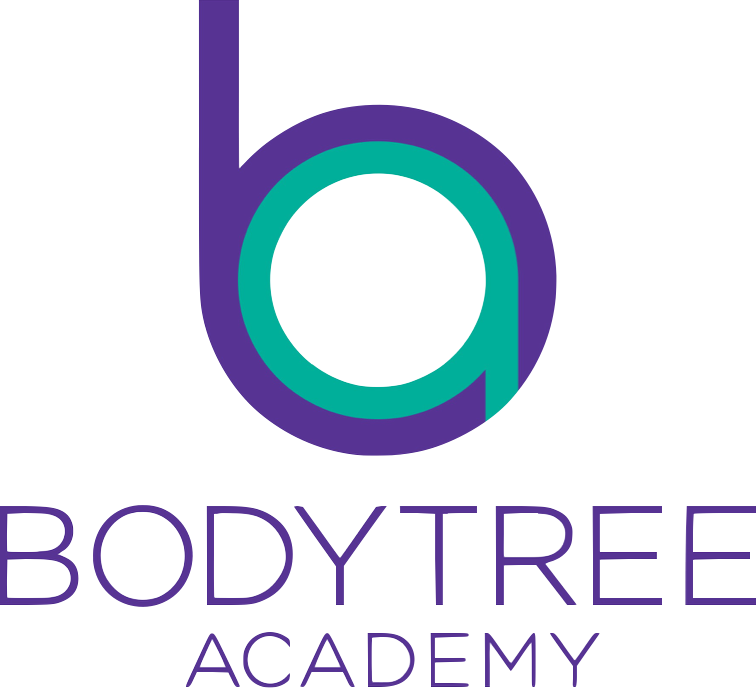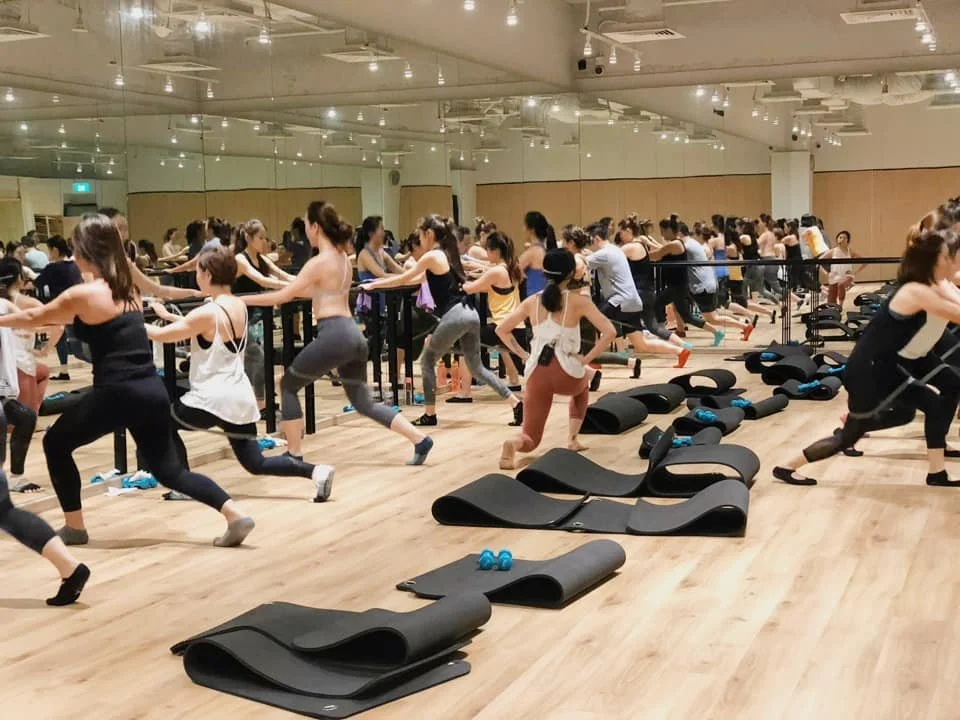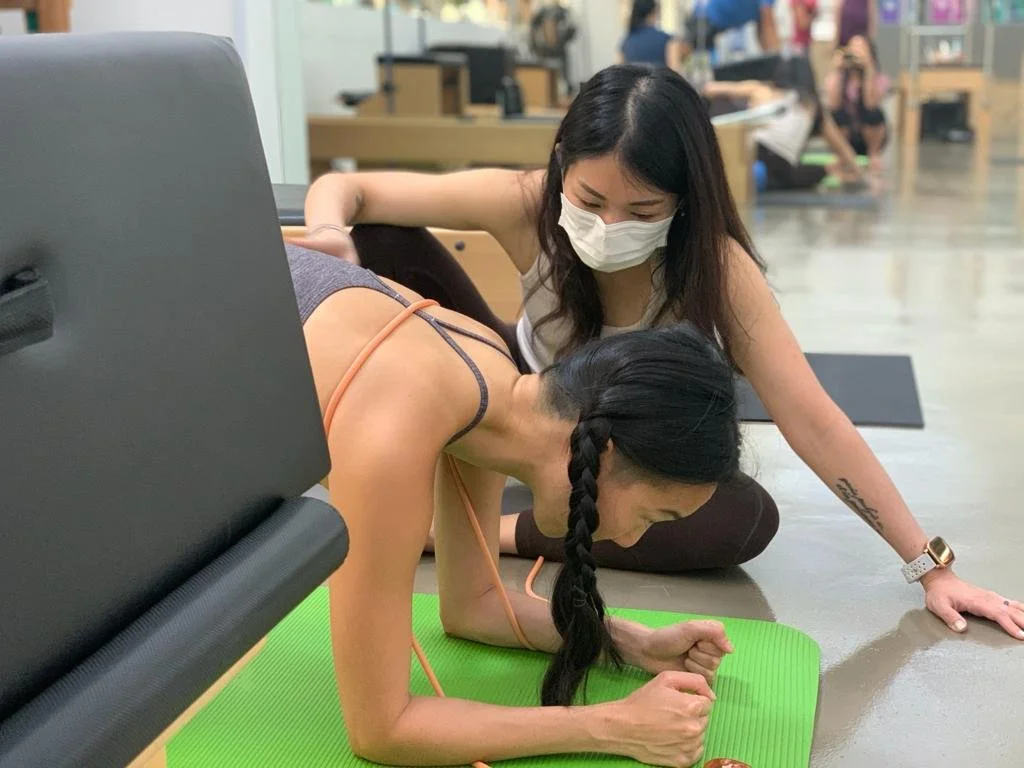Specificity in 1-1 Teaching
In terms of teaching, my only group setting of teaching at this time of writing are Children’s graded ballet classes. The bulk of my teaching time is now 1-1 sessions in the Pilates Studio, and when clients seek me out, it is for 1-1 training.
Before my 1-1 focus, I did teach group fitness; Barre fitness to be exact. My classes would run as 2 back to back evening classes, 95% of the time these classes would be filled to the maximum capacity (22!, precovid of course).
That’s me in the middle - making sure I cue on time with the music, ensuring I speak clearly into the microphone, demonstrating with my 100% effort trying to keep form, giving easy corrections to get everyone in the best form possible, and also making sure I don’t trip over all the mats and weights on the floor!
And don’t get me wrong, I LOVE the energy of a group setting; there is always a high and deep satisfaction when the group starts moving in sync and a PLUS when people are on the edge of giving up but pushing through together. Having danced before, I enjoy (read as MISS) moving as a group and feeling the room’s energy. From time to time I still drop in for a yoga class to experience the same feeling of moving as a group. But I knew I could “do more” by helping in a 1-1 setting.
Who are my clients?
some seasons I get more dancers (again seasonal because it depends on competition season/why they are seeing me)
But they all have the same goal of wanting to be able to enjoy the things they do pain free or without discomfort. While the Human Body is a Human body, EACH body comes with its own history, baselines and nuances.
For example, when I work with a Hypermobile individual, tension spots may not be obvious since most of them don’t experience it as a loss of Range of Motion or Tightness in the conventional sense. Being hypermobile sometimes also means loss of joint position awareness, which makes controlled work a lot more taxing than a “regular” person.
For sports performance, it is about optimising output and also about being able to work out any “weak links” along the chain, and building coordination among parts to become more efficient in movement (actually non athlete or athlete, everyone should work towards movement efficiency!).
In such cases, giving generic exercises or advice would not work - whether it is someone who moves well or who has poor motor control, specificity is what will get them the progress they seek.
So how does one go from Instructing a group to Teaching an individual? While this could be a topic of pedagogy, if we look rather at a Teacher’s toolbox, further education in movement science is what will help take your teaching into a deeper level of specificity. Below are some courses I recommend; these courses are easy to learn, with sufficient scientific detail that if you want to go deeper you can, and mostly, applicable (I have seen their effects and progress in my own clients).
Foot as the Foundation - Evidence Based Fitness Academy (EBFA Global) Barefoot Education
If you follow any fitness accounts, you’d probably notice how much people are sharing about how important foot health is in optimising strength gains, and getting out of pain.
You have Dr Emily Splichal, Podiatrist and Human Movement expert and founder of EBFA global to thank - Dr Emily is an innovator, and teacher, and you can see this in how her courses are delivered and structured; always updated with the latest in barefoot science YET easy to understand for movement teachers with useful assessment tools to use in the 1-1 setting.
The EBFA courses literally changed the way I viewed feet (especially in the dance studio) and in my teaching in the Pilates studio. Understanding foot biomechanics also helped me appreciate what it means for students who have bunions, and ensuring safety in developing foot strength in young ballerinas. The courses also opened my eyes to my “tight” ankles - which for years many dance teachers said I needed to stretch, when my problem wasn’t actually a lack of flexibility in the calves.
In Singapore, the Level 1 and 2 courses are taught by my mentor, Jerry, who has been teaching Pilates for 19 (maybe more) years. The courses are assisted by Alycia who was my mentor for my Royal Academy of Dance Teacher Certification - so besides course content, you will be learning from 2 individuals with a wealth of knowledge!
Helping you decide if your client to stretch or strengthen - Muscle Testing Workshop by BodyTree Academy
I know this sounds like I am advertising the academy (somewhat yes, but it is a vicious cycle of argument since we only bring in courses we believe in!) - but learning how to do basic muscle testing has given me a very objective way of understanding what my clients need, especially when the issue is not very obvious - this is especially useful in my clients who move very well, but express a “weird” feeling in joint as they move.
While you can’t exactly isolate a muscle to test it, the methods give enough information to devise a hypothesis and test it out to see if it helps with the “weird” feeling - it has 100% of the time with my clients so far (I hope I don’t jynx it!).
The course is full of hands on - a great platform to work on your 1-1 interactions as well.
Optimizing Core Stabilisation - Dynamic Neuromuscular Stabilisation by the Prague School of Rehabilitation
We all know that good trunk stability starts with “good breathing” - and we have all done this before by telling our clients to “use their core”. But what does it mean? As in, what does it mean to you when you say “use your core” and what does it mean for your client to actually be engaging?
Engaging muscles around the waist is one thing - how then we do know if this is optimal stabilisation and not a compensatory pattern? In Pilates we like to say “strong from the inside out” but what does it mean to our clients?
The Dynamic Neuromuscular Stabilisation course is a course that describes what it means to stabilise optimally - their approach is that based on developmental kinesiology; and there is a lot of hands on assessment on breathing and stabilising, which can be immediately applied in your 1-1 teaching.
Lots of great blogs speak about good breathing and intra-abdominal pressure like this one here. But if you are looking for a practical course to learn from, DNS is a great one to go deep on breathing and what it means to have good core control.
“the most important investment you can make is in yourself” - Warren Buffet
Besides being able to help people more directly, 1-1 teaching sustains my energy as a teacher. If you are teaching loads of group classes and are unsure about making a change, the best advice I can give you is to still take up some continued education courses. Maybe once you have experienced it, you will get a better idea of whether this is a path you wish to pursue!



